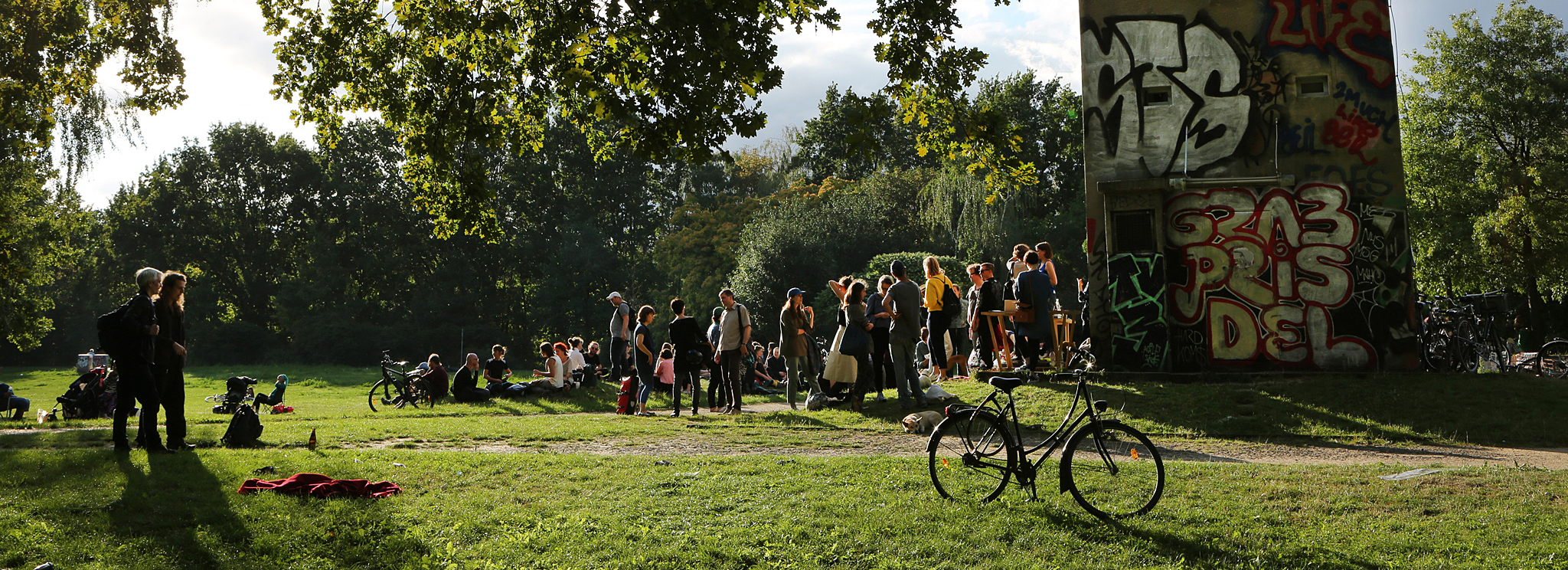Between the stark concrete housing blocks and weedy open spaces of Hellersdorf, a model example of East German housing infrastructure built on the peripheries of Berlin in the 1980s, capitalism still often feels like an intruder. Instead, “shopfront” spaces facing the shadowy concrete promenades of this area and its neighbor, Marzahn, are of late often occupied by community-oriented studios and art spaces, as is the case for mp43.
Carola Rümper and Marnie Müller, the “two-stroke engine” behind mp43, gave their one-day event the unassuming title Topflappen (oven cloth) for the simple reason that this is an object everyone and anybody can identify with. Certainly, those PSF regulars who made it out to the far end of the U5 that hot Monday afternoon were met by another public from the very center of Hellersdorf.
Regardless of our differences, everybody has had a home of sorts, and everybody knows nostalgia. Babel was a participatory project by Sandra Schmidt consisting of an installation and collection of stories around small, hand-made paper houses produced by exhibition visitors themselves – adults, children, and everybody in-between. It was surely the artist’s aesthetic decision that the houses were strictly to be made without a floor – the resulting hanging display formed pleasing shadows on the walls of the space. At the same time, I could not help thinking that, in a contemporary do-it-yourself world, fabricating one’s own provisional infrastructure is often a lonely business.
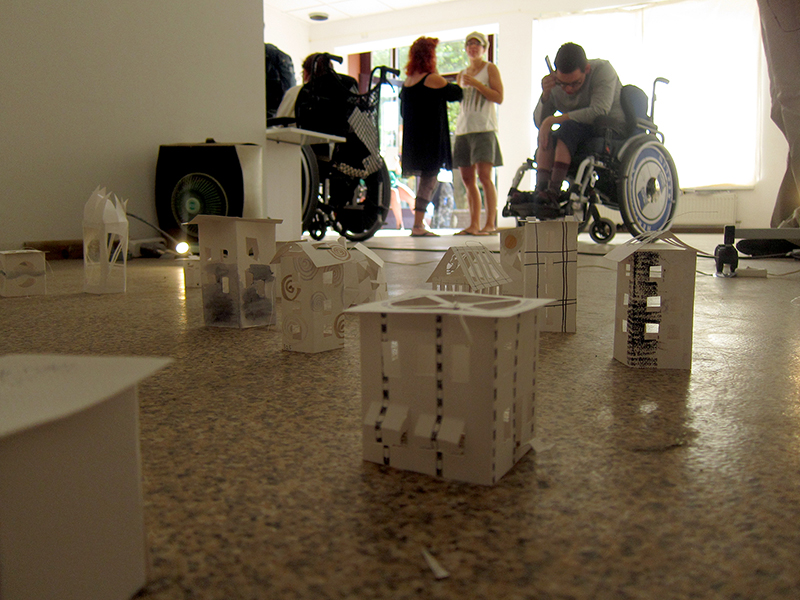 Sandra Schmidt, Babel, participatory work, 2016
Sandra Schmidt, Babel, participatory work, 2016
Photo: Why Alix
Outside, in the sun, a game for exhibition visitors designed by Kirsten Wechslberger thematized questions surrounding age, sexual orientation, skin color, health and other issues touching on marginalization. My participation was limited to an animated conversation about tattoos and whether it is possible to feel marginalized when wearing a T-shirt printed with the image of a naked woman in a suggestive pose. The question, I felt, was not so relevant to the wearer of said T-shirt, a softly-spoken man with Down’s Syndrome. For a moment, I envied the white-haired citizen who kept watch on us from the safety of her balcony umbrella above.
Project Space Festival Day 9: Galerie BRD
Moabit’s Stromstraße runs along a construction site, its fencing draped with wine-red banners announcing a new shopping-mall and “studios in heritage-listed buildings designed for artists and creatives”. Shortly before Stromstraße turns off to the next shopping mall and runs in the form of an elevated bridge to Westhafen, the Berlin project space Å+ can be found. Temporarily taken over by Galerie BRD, an initiative invited to Berlin for the Project Space Festival, Å+ hosted second co-operation between two parties who negotiate whether and how they might use one another: Cosmin Covacju and Jasmina Ferouca, both from a Leipzig-based Sinti and Roma community, and Uwe Greiner, who runs a trade in scrap metals with Covacju and accompanies him in his dealings with German authorities. In return, Greiner was the recipient of a letter of recommendation, written by Ferouca, which grants him the hospitality of the Roma community. In every element of this exhibition, cost was weighed up against use – even the scrap metal was carefully sorted and arranged by Covacju and Greiner according to type. The handwritten price and weight of each collection of metal beside each collection was a reminder that the elements of the exhibition had nothing to do with art. They were stored in the project space, to be collected and sold on at a later date. Covacju and Greiner themselves are nowhere to be seen – it wouldn’t have been worth it.
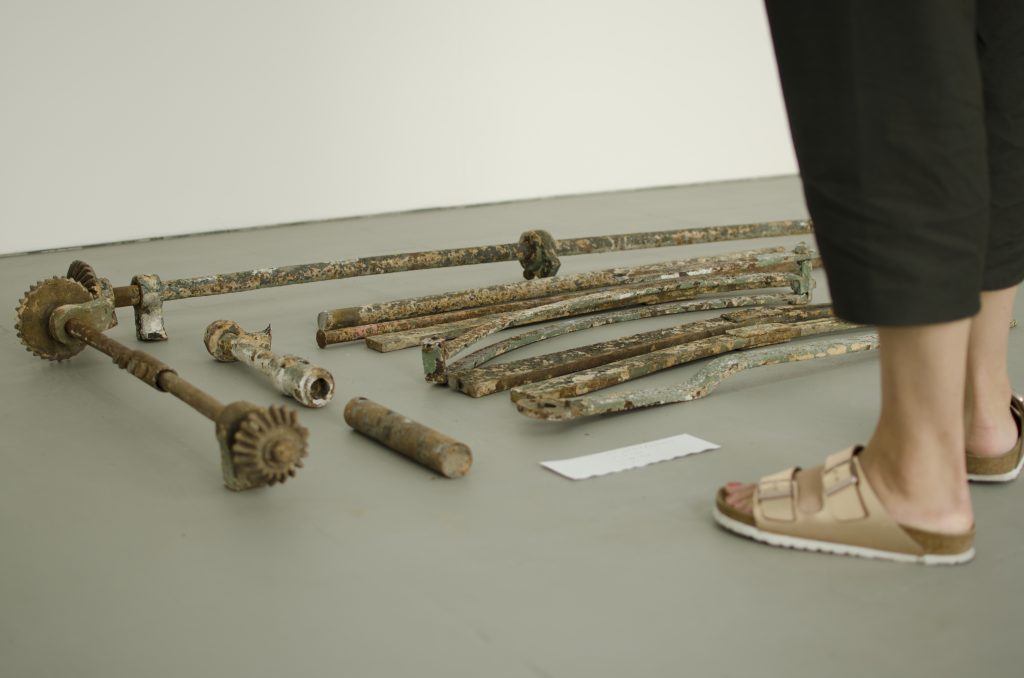 Galerie BRD with Cosmin Covacju, Jasmina Ferouca & Uwe Greiner, Zwei verhandeln, ob und wie sie einander nützen können, installation view, 2016
Galerie BRD with Cosmin Covacju, Jasmina Ferouca & Uwe Greiner, Zwei verhandeln, ob und wie sie einander nützen können, installation view, 2016
Photo: Why Alix
Project Space Festival Day 10: Raumerweiterungshalle
The Raumerweiterungshalle, or “spatial extension container”, is a portable architectural form designed in the 1960s and 1970s in the DDR – a building in eight pieces that can telescope in on itself. One such Raumerweiterungshalle is now a project space parked next to About_Blank close to Ostkreuz, a cosy corner put to use for film evenings, performances, readings, concerts, seminars, discussions, exhibitions, and workshops. The focus on a queer-feminist mode of self-education emerged out of Berlin’s student strikes in 2003 with the intention to sidesteps elitist prerogatives and economic competition – a tradition continued by the space on Wednesday evening.
In the crisp cool air, we crowded around an outdoor campfire before filling the Raumerweiterungshalle for a conceptual lecture, video work and music performance by a group of four individuals who, as non-artists, staked their claim in the Project Space Festival, pushing the limits of the project space as an exclusive “artist’s” zone.
Coco Detrow, Hanna Bergfors, Nai Fowler and Ari Robey-Lawrence’s lecture, read to the audience through a disembodied voice-recording, began with the observation that we are likey the last human generation to live out our lives only in the bodies we were born in. Yet the body is more than mere flesh. Social and cultural structures shape it into being, rendering certain forms, specific skin colors, and particular ages more desirable and therefore powerful than others. What happens when it is possible for some to buy and sell these attributes? Is the result an upper class of bio-political elites (which the “art world” simultaneously comments on and belongs to)? And how might it be possible to claim a zone of pleasure again for difference?
The lecture-performance was accompanied by a mesmerizing looped film, shot slow-motion, in which the camera circles a white woman in black sports underwear in perpetual motion. She could be an avatar, a clone-in-waiting, or a spare body – except that her flesh is too human, too close, and far too real.
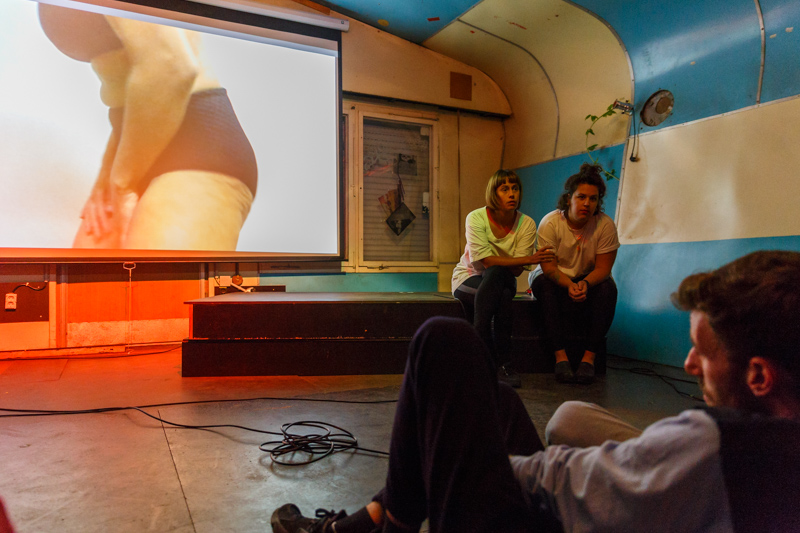 Coco Detrow, Hanna Bergfors, Nai Fowler & Ari Robey-Lawrence, Hot Chix: Neither Here nor There // Geile Uschis: weder hier noch dort,
Coco Detrow, Hanna Bergfors, Nai Fowler & Ari Robey-Lawrence, Hot Chix: Neither Here nor There // Geile Uschis: weder hier noch dort,
multimedia durational lecture-performance, 2016
Photo: André Wunstorf
Project Space Festival Day 11: Santa Lucia
Niko Solorio, buried in a black leather sofa and surrounded by sound devices – above him, a projection of a curtain softly blown about by an open window. It feels like the decision to linger in bed after just having woken up. And indeed, there is Niko, crooning into the mike: “I’m about to stay in bed, I’m about to set a trend, I’m about to make you forget”.
At Santa Lucia, Niko Solorio and Rebecca Salvadori provided a glimpse into their year-long exchange, as if opening a diary telling of the subtle way in which they have woven together their works, setting off sparks of dialogue. Over the years, Rebecca Salvadori has developed an internally reduced formal language which crept into Niko Solorio’s videos, but also claimed its own space in the form of a series of large, glossy prints hung on the walls.
A single print was separated out and hung in the entrance space above two empty chairs set facing one another. This was a decision made by the two artists together, marking the first time Rebecca Salvadori allowed another into her hermetic process of finding form.
While the abstract, visual language of Rebecca Salvadori maked use of a strict austerity, the musician, artist and media artist Niko Solorio proceeded with a certain sleepy nonchalance which also can be seen in his music and self-produced music videos. “A lot of police cars went past our window while we were making this recording. We liked the sound of the sirens and simply kept them in”. Street scenes filmed from an apartment, such as a street preacher or passing blue lights, array themselves alongside rainbow test patterns and Niko dancing with a hula hoop.
The video broadcasts a mantra: “Bitch I’ll knock you out. I’m just talking to myself”, while Max Dax and Luci Lux prepare everything for a parallel evening meal at Santa Lucia, the ‘gallery of dialogues’.
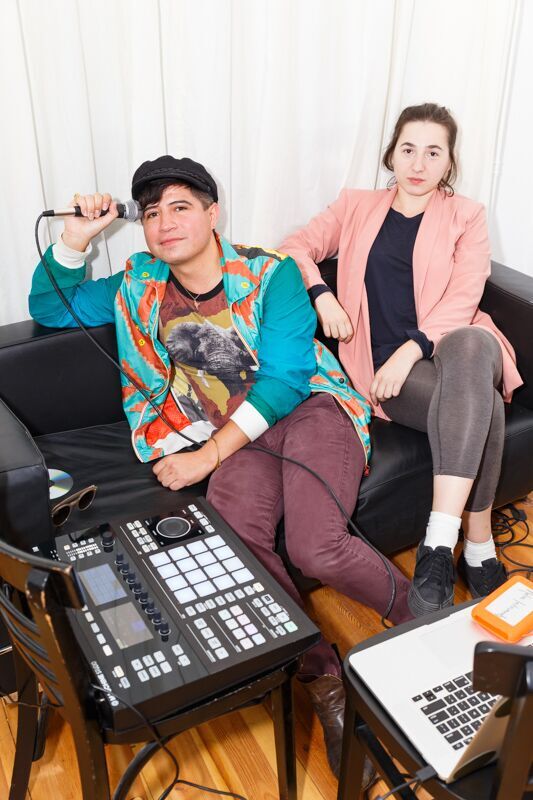
Niko Solorio & Rebecca Salvadori, Niko Solorio and Rebecca Salvadoriin Dialogue, 2016
Photo: André Wunstorf
Project Space Festival Day 12: uqbar
uqbar – a fictitious entry in a found encyclopedia described in a short story by Borges – is a literary placeholder for how meaning is constructed. Together with its neighboring spaces Copyright and Kronenboden, uqbar is also a project space and an integral part of Kolonie Wedding, a series of art initiatives in Berlin’s north set up with the support of one of Berlin’s six municipal housing companies.
For the Project Space Festival of 2016, in a gesture of hospitality these three spaces made the decision to open their rooms to a fourth guest – U10 from Belgrad, Serbia. U10 was founded in 2012 by artists, for artists, in order to afford visibility to new practices in Belgrad which otherwise would lack representation in the city’s pre-existing commercial or institutional formats. Of late, the space also hosts exchanges between artists and curators throughout the former Yugoslav region.
It’s hard to describe why, but I caught a certain spirit of resigned determination hovering over the exhibition, which contained drawings, paintings, an installation and video works by the seven artists who initiated U10: Lidija Delić, Nina Ivanović, Sava Knežević, Isidora Krstić, Iva Kuzmanović, Nemanja Nikolić and Marija Šević. Perhaps it began with Iva Kuzmanović’s 20-second-long looped video, entitled Things can change, in which a painting of a skull, arriving from a distant vanishing point, constantly enlarged itself to fill the screen, disappeared, and then began again. In fact, nothing changes, it’s all just slapstick, the work seems to tell me – and everything I might conjure up that might contradict this would just be escapism.
Nemanja Nikolić’s Panic Book, the only work in the exhibition referring explicitly to the past, animated excerpts plucked out of Hitchcock suspense scenes and painstakingly drawn into the pages of socialist Yugoslav educational texts from the same era. Two ideological systems overlap here, forming a careful dramaturgy for suspense that emerged in the Cold War conflict.
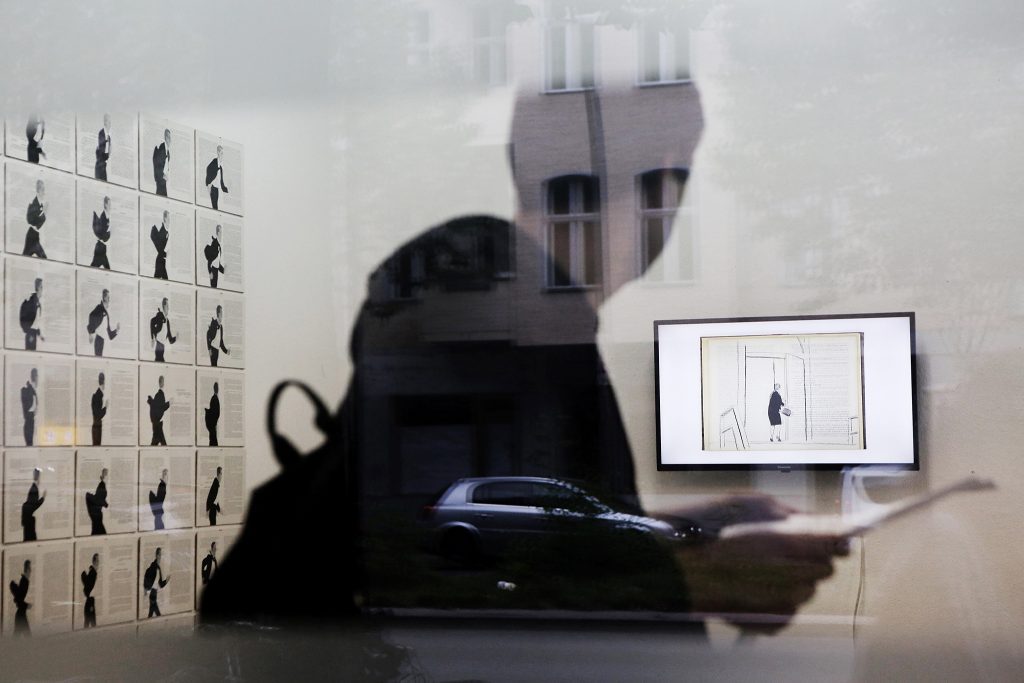 Nemanja Nikolić, Panic Book, 2015, Wall installation (60 drawings, ink and crayon on books mounted on wood, dimensions variable)
Nemanja Nikolić, Panic Book, 2015, Wall installation (60 drawings, ink and crayon on books mounted on wood, dimensions variable)
Photo: Joanna Kosowska
Delicately handled, Nina Ivanović’s ink on paper works (In right place, 2015/16) provide intimate glimpses or snapshots of tourists in an empty landscape, a shirtless man in a museum, a tiger floating on a shoulder: banal moments suddenly invested with tension by wavering lines and spots of color. Marija Šević’s large, glossy and dark paintings Ecstasy (2016) and The return to nature (2015) similarly depicted young people – seemingly caught out – in isolated moments of uncertain hedonism, squatting in a forest or cosseted in a large bed, leaving a bitter taste of lonely luxury. In fact, U10 recently took part in Art Basel. Another painting by this artist – not included in the exhibition – bears the emphatic title Alone in the art market.
In the conversation between the space’s initiators, Aleksandra Jovanić from Belgrade’s University of Arts, and the public, questions came up about the politics of representation. What has happened to the “older-generation” artists who were already adults during the war? To what extent is it possible to talk about “common ties” in the former Yugoslav region? Above all, my impression was that U10, operating with care and determination, aims to make a fresh start.
Project Space Festival Day 13: NON Berlin
It couldn’t have been a greater contrast. We travelled through a lively Saturday evening to Berlin-Mitte up to the point where Chausseestraße bends off and quietens down, taking us to the bright spaces of NON Berlin. Kyung Kim, who designed the space for the exploration of social norms of screaming, had hung an arrangement of unstretched canvas stretchers on the wall. These wooden supports, usually covered by canvas, were – together with an array of tools – dug out of the storage cellar of the space, offering a setting for the search for the hidden.
The project love! The hidden voice, a performance, installation and sound work and part of the series NON 論 DA 多 {PLAY}, has made its task the exploration of screaming as a particularly emotional and deviant mode of behavior. But those who expected an unmediated encounter with the art of screaming were surprised. The performance by Sumi Jang proceeded with a long, wavering silence broken by occasional tentative tones generated by Jang and her partner Miriam Siebenstädt with the tools lying around.
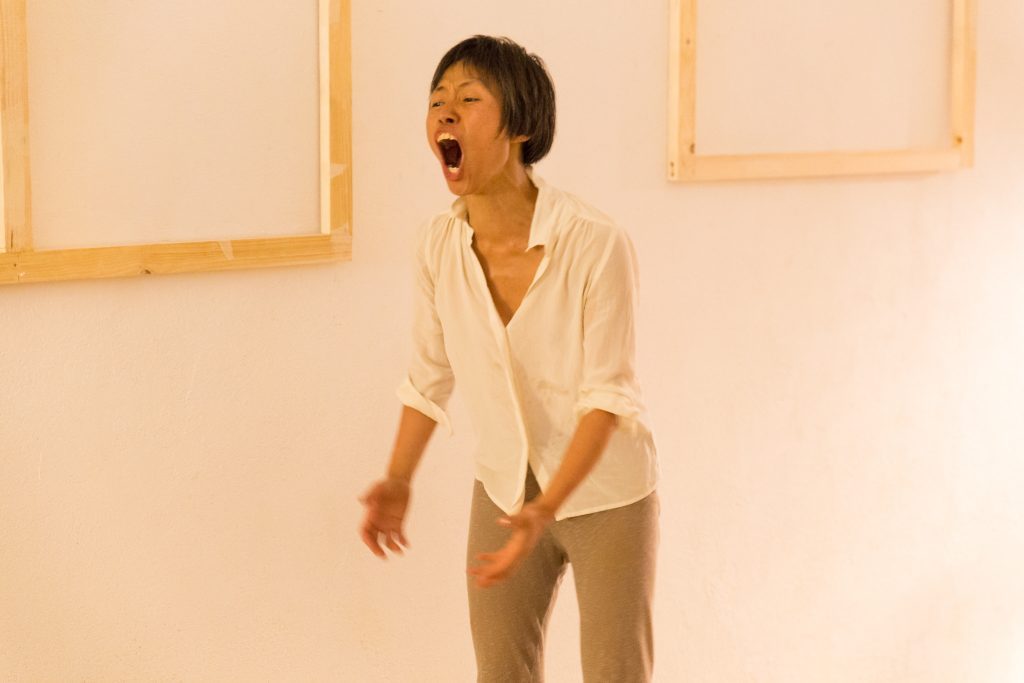 Su-Mi Jang & Miriam Siebenstädt, love! the hidden voice, 2016, performance, spatial design by Jae Kyung Kim
Su-Mi Jang & Miriam Siebenstädt, love! the hidden voice, 2016, performance, spatial design by Jae Kyung Kim
Photo: André Wunstorf
Rather than musical instruments, the sound produced by various saws played with violin bows filled the space. Visitors, positioned in the middle of the space on displaced row of seats, while the play between the two performers moved around them. When Sumi Jang asked a number of the viewers when they had screamed for the last time, she received a surprisingly broad range of answers. The artist encouraged viewers to scream together – creating sound which, as if from a parallel world, filled the space for a long moment, before Jung herself began to prepare for her own scream. This came out, to begin with, in the form of an ossified silence expressed only through her tensed physical movement.
The hidden scream – the failure of the voice – generated an overwhelming impression of powerlessness. After continued attempts a sound was pressed out, all the more resonant for its repressed fury and rattled pain. The disturbing effect of this sound was assessed by the viewers in the following conversation in a completely different way depending on the sex and cultural background of the speaker. While it was the performers’ intention to draw attention to screaming as a form of social deviance of the woman in the context of Asian societies, a viewer with a Greek background proved herself to be well-versed in screaming as an art. In the Mediterranean, screaming is a normalized mode of expression of grief, for example, and be practiced without social taboo. The discussion set into motion the European-Asian exchange understood by NON-Berlin to be its mandate.
Project Space Festival Day 14: District
Mythical figures are hybrids that exist between worlds – the animal and the human, the past and the present, the sea and the land. Two women-artists negotiate materializations of the conflict-laden space between these zones in District’s THE MANY-HEADED HYDRA, a one-day exhibition in the Grenzwachturm of Berlin-Treptow. In small groups, visitors climbed the tower and encountered two artworks articulating two mythic and current figures of resistance.
A South-East Asian woman was brought to Europe in the 1880s by the German hunter Brietwiser. The woman performed in Hamburg’s colonialist “Völkerschau” as a snake charmer. A chromolithograph image of her eventually circulated back to West Africa, where locals identified her as Mami Wati, the androgynous African water spirit worshipped since ancient times and since then also associated with snake charming. Ato Malinda has channeled Mami Wati in her film On Fait Ensemble, in which a white-clad black woman hovered in the tangled green undergrowth beside a slow-moving river, accompanied by the words of poet Langston Hughes: “I’ve known rivers ancient as the world and older than the flow of human blood in human veins.” Glimpses of Mami Wati were cut with scenes of Malinda performing Mami Wati’s Beninese counterpart Papai Wati, a white-painted face disseminating images in a contemporary marketplace – the intrusion of the white European male. But Mami Wati also floated, disembodied and ghost-like, through these everyday incidents of transportation and trade. Can an ancient spirit help to address today’s problems?
Bryndis Björnsdottir’s performance drew on the Mountain Woman, a figure of both Icelandic and Kurdish origin. In Iceland, the Lady of the Mountain (fjallkonan) represents a nation-state’s longing for political and economic independence, but has also been important to the island’s strong feminist history. The Kurdish mountain women, on the other hand, represent a group fighting for a stateless ideal. The artist channels both figures, creating an inverse political resistance to the “Quota kings”: large Icelandic fishing conglomerates who buy up fishing rights from small-scale fishermen. Of late, Iceland’s fishing kingdom has also extended to north African waters. Out of these muddied waters arose the artist’s strongwoman, wraithed in black and bathed in the stench of washed-up fish, squatting in an arranged and shining spectacle of the sea, her fake pink eyelashes, gumboot headdress and makeup all props for a fighter dirge sung at full pitch: a subaltern Quota Queen announcing the accumulation of the commons by capitalist forces.
Take care, I was reminded: with the waters of rivers and seas in our veins, human beings and fish share more than meets the eye.
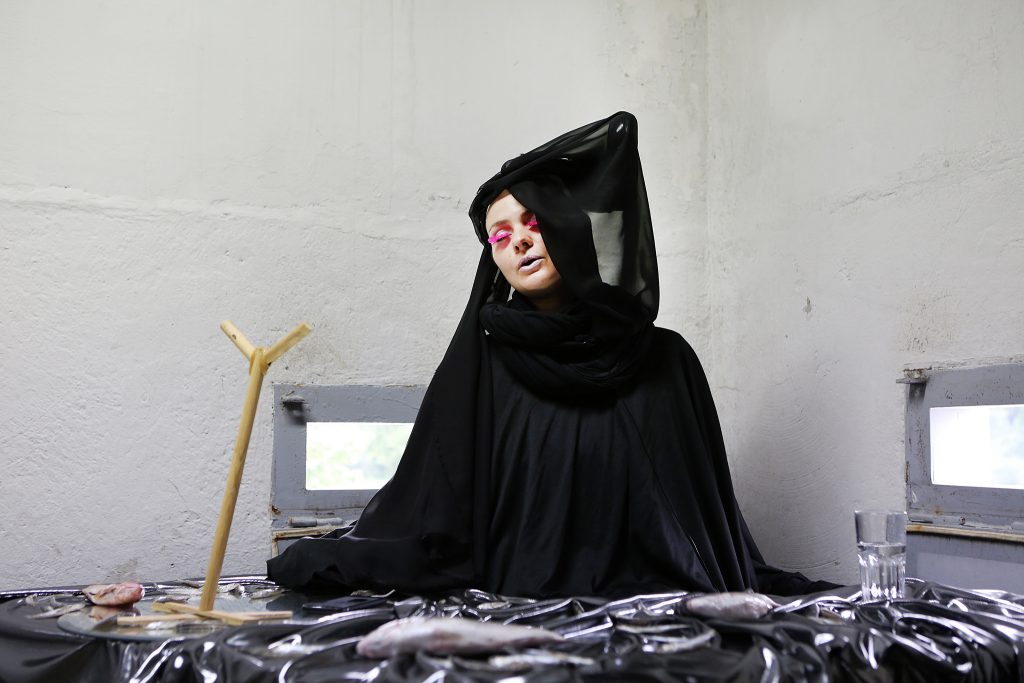
Bryndís Björnsdóttir, Mountain Woman – Tunes to FaceTime, 2016, performance
Photos: Joanna Kosowska

